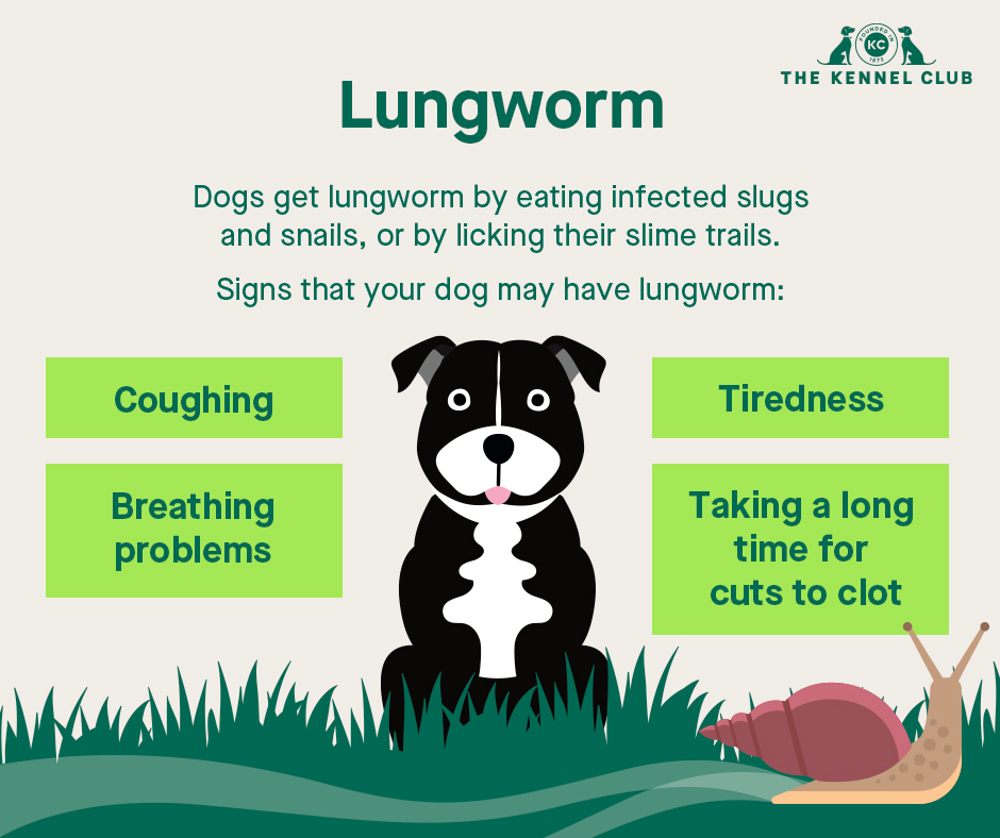
What is lungworm?
Lungworm is a type of parasitic worm (known as Angiostrongylus vasorum) which affects dogs and foxes (who are often implicated in spreading the disease). Once dogs are infected, adult lungworms live in their heart and the major blood vessels supplying the lungs, where they often cause a host of potentially serious problems.
How do dogs get lungworm?
Unlike many diseases, lungworm is not actually passed directly from dog to dog. The worm needs slug and snail hosts in order to grow and develop, and it's from eating these that infection may occur. Dogs then pass larvae in their waste, which in turn infect slugs and snails. So the more infected slugs and snails eaten, the more likely disease is then rapidly spread within dog communities.
When are dogs likely to become infected?
Wet spring months usually mean you'll see a fair few slugs and snails around and they've all got the potential to carry the dangerous lungworm parasite. So when your dog rummages through undergrowth, drinks from puddles, eats grass, or generally sniffs around outside; they can end up eating these slugs or snails either accidentally or on purpose. Although slugs and snails can give off foul-tasting substances that prevent them from being ingested, some dogs just appear to ignore these warnings. Also any contact with the slime trail in outdoor food and water bowls, even over toys left out in the garden, can be enough to cause infection too.
What are the effects of lungworm?
After infection, lungworm usually causes progressively worsening signs of cardiac and respiratory disease, such as coughing (often at 'extremes' of exercise); as well as causing bleeding in the lungs, liver, intestine, eyes, and spinal cord, but also pretty much anywhere in the body. If left untreated, it can become fatal.
How can I tell if my dog is infected with lungworm?
Lungworm is often a chronic disease, lasting months, even years. Signs of lungworm disease are vague, and easily confused with other illnesses, including:
- Weight loss
- Breathing difficulties
- Coughing (especially bringing up blood)
- Lethargy
- Poor blood clotting/persistent bleeding
- General sickness
- Circling
- Stomach and back pain
- Poor appetite
- Vomiting
- Diarrhoea
- Behaviour changes (depression, being tired)
- Seizures
How is a lungworm infection diagnosed?
An absolute diagnosis of lungworm is difficult and involves a variety of diagnostic methods, such as blood samples for DNA, analysis of stool samples for eggs and larvae, chest x-rays, even bronchoscopy.
Interestingly, not finding worms doesn't mean your dog isn't infected. Diagnosing lungworm infection is often based on history, compatible clinical signs and response to treatment.
Which dogs may be prone to becoming infected by lungworm?
Dogs of all ages and breeds are susceptible to lungworm, with playful, younger dogs (less than 2 years old), unsurprisingly, more prone to picking up the parasite. Dogs known to purposely eat slugs and snails are obviously considered higher risk.
How common is lungworm?
Lungworm is what we call an 'emerging' disease: it's gradually becoming more common. Until recently it appeared only in select 'hot spots' in the south of the UK, but over the last few years, it's been successfully identified in various parts of the country. It's unclear exactly what's caused this spread, but increased movement of pets around the country, and abroad, as well as greater contact between wildlife and the urban environment are all thought to be very influential factors.
Lungworm - uncommon, but extremely serious
Not every snail or slug carries the disease and lungworm's geographical limitations means infection is currently relatively uncommon, but it does rear its head from time to time. In extreme cases it causes the death of infected patients, so it is potentially extremely serious.
What do I do if I think my dog may be infected?
If you're concerned your dog has picked up lungworm, is displaying signs of the disease, or is at risk from lungworm infection, then call your vet immediately. Lungworm treatment is widely available from your vet and extremely easy to administer. Once diagnosed and treated, most dogs make a full recovery and, like all diseases, the key to successful treatment is taking action early.
What treatment will my vet use?
Killing lungworm is relatively simple, and involves making sure your routine, preventative anti-parasite treatments administered to your dog are appropriate. No invasive or expensive treatments are indicated when disease is caught early. However, the more advanced the effects or level of infection, the more significant the permanent damage is likely to be, so the more costly any veterinary treatment required will be.
How can lungworm be prevented?
Your vet may provide you with some simple treatments that you can apply to protect your dog from lungworm, as well as other parasitic worms and fleas. If you spot slugs and snails in your garden or local park, be extra vigilant when out walking your dog. Always pick up and safely dispose of your dog's faeces, and consult your vet as soon as possible if your dog becomes unwell.
Think your dog may be affected?
If you're worried about your dog's health, always contact your vet immediately!
We're not a veterinary organisation and so we can't give veterinary advice, but if you're worried about any of the issues raised in this article, please contact your local vet practice for further information.
Find a vet near you
If you're looking for a vet practice near you, why not visit the Royal College of Veterinary Surgeons' Find a vet page.
